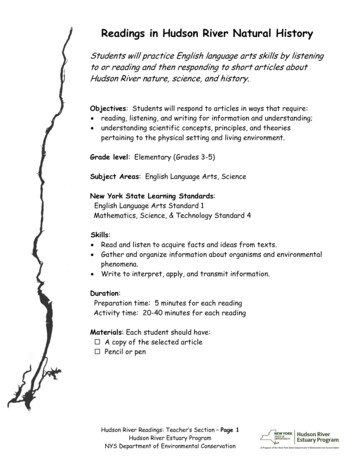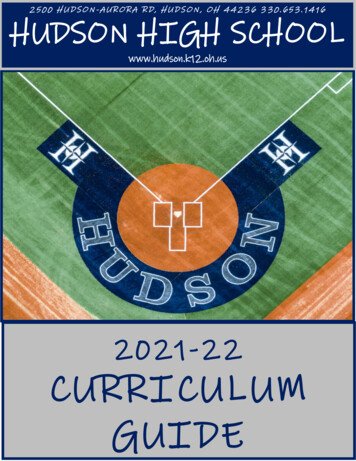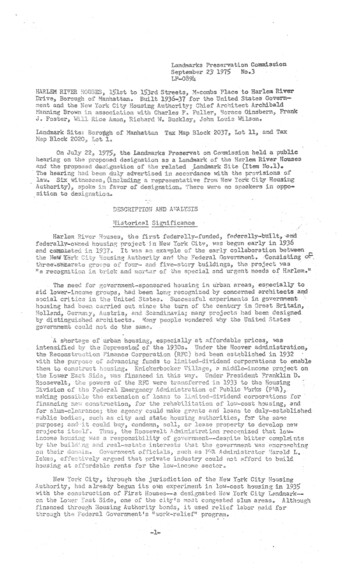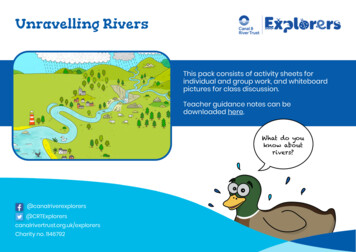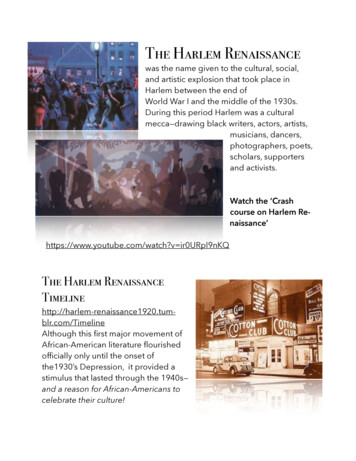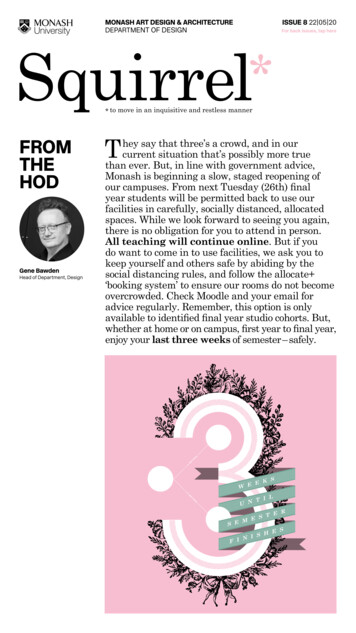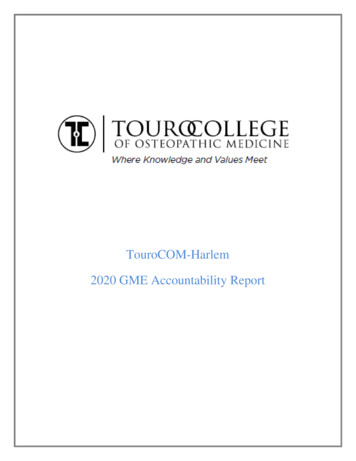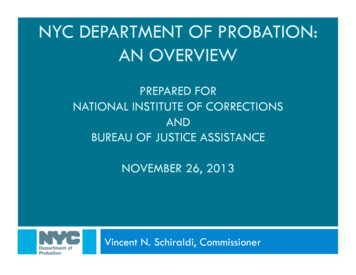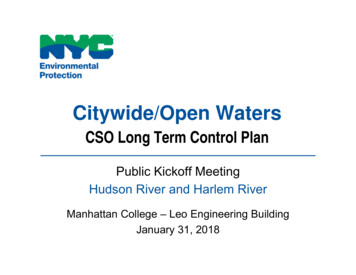
Transcription
Citywide/Open WatersCSO Long Term Control PlanPublic Kickoff MeetingHudson River and Harlem RiverManhattan College – Leo Engineering BuildingJanuary 31, 2018
AgendaTopic1 Welcome & Introduction2Waterbody & Watershed Characteristicsand Water Quality SamplingSpeakerMikelle AdgateKeith Mahoney3 Water Quality Improvement Projects Grey Infrastructure Green Infrastructure4LTCP Modeling & AlternativeDevelopment Process5 Next Steps6 Discussion and Q&A SessionKeith MahoneyMelissa EnochKeith MahoneyMikelle AdgateAll2
Welcome & IntroductionMikelle AdgateSenior Policy AdvisorDEP3
What is a Combined Sewer Overflow (CSO)? NYC’s sewer system is approximately 60% combined, which means it isused to convey both sanitary and storm flows.Stormy Weather ConditionsDry WeatherConditionsDownSpoutDownSpoutCatch BasinCatch BasinBuilding SewerConnectionCombinedSewer OutfallCity Sewer MainBuilding SewerConnectionCombinedSewer OutfallCity Sewer MainSewerRegulatorSewerRegulator 65% to 90% of combined sanitary & storm flow is captured at treatment plants. When the sewer system is at full capacity, a diluted mixture of rain water and sewagemay be released into local waterways. This is called a combined sewer overflow (CSO).4
How does rainfall affect CSOs? Rainfall characteristics thattrigger a CSO event at HudsonRiver and Harlem River: Constant rainfall over a periodof 2 to 10 hours totaling 0.4 to 1inch Not every rainfall causes aCSO event: Approximately 25% of theaverage rainfall events per yearmay trigger a CSO at HudsonRiver and Harlem RiverPhoto Credit: Baptisete Ponshttps://www.flickr.com/photos/bpt/2882285636/5
What is a LTCP and CSO Consent Order?Long Term Control Plan (LTCP)identifies appropriate CSO controls to achieve applicablewater quality standardsconsistent with the Federal CSO Policy and Clean Water ActCSO Consent Orderan agreement between NYC and DEC that settles pastlegal disputes without prolonged litigationDEC requires DEP to develop LTCPs and mitigate CSOs6
LTCP Process and Public InvolvementExistingInformationReviewDataCollection velopment& EvaluationPrepareLTCPAlternativesMeetingTBDSubmit toDECFinal PlanReview MeetingTBDONGOING PUBLIC/STAKEHOLDER INPUT7
Harlem & Hudson River in Phase 1 Sampling The Citywide/OpenWaters SamplingProgram was dividedinto 3 PhasesPhase 1 SamplingHudson & Harlem RiverWI-056NR-043WI-060 Harlem and HudsonRiver were coveredunder Phase 1NC-076Phase 3 SamplingNY HarborPhase 2 SamplingEast RiverLTCP-02 Proposed Sampling LocationsOpen WaterShorelineCSO Outfalls to be Monitored8
Public Comments Received1)1Consider Green Infrastructure as PreferredAlternative2)2Fund maintenance for all GI projects beingbuilt3)3Keep to Harlem/Hudson River LTCPPlanning Schedule45)56)6Begin EAS process concurrent with LTCP7Consider Specific Alternatives:4)7)Host Separate Meetings forHarlem/Hudson RiversAdopt new Design Criteria to achieve zerodischarge to local pipes1)Recognize Tibbetts Brook Daylighting andBrook Park Wetland Projects as GI Projects2)Assess for Rain Gardens in vicinity ofHudson/Harlem Rivers3)Consider Private Sector for GI Projects4)Consider Waterfront Development/GI9
Waterbody & WatershedCharacteristics andWater Quality SamplingKeith Mahoney, PEDirector of Water Quality PlanningDEP10
Drainage es)4876,833North River4,921571Hunts Point-1,0061,158-WWTPWards IslandNewtown CreekTOTAL6,566(82% combined sewers)8,410(90% combined sewers)11
Land UseResidentialMixed ResidentialCommercial and OfficeIndustrial and ManufacturingTransportation and UtilityHarlemRiverPublic Facilities and InstitutionsOpen Space and Outdoor RecreationParking FacilitiesVacant LandHudson RiverHarlem RiverHudsonRiverHarlemRiverResidential28%33%Mixed Residential & Commercial14%7%Commercial14%4%Transportation & Utility9%7%Public Facilities13%12%Park & Open Space17%31%Other5%6% 12Land UseHudsonRiver
Hudson River CSO Outfalls21%61%61%NR‐02710%8%CSO917 MGY(52 Outfalls)MS41(2 Outfalls)Other*NCM-634NCM-628174 MGY588 MGY*Includes direct drainage and other non-DEP stormwater13
Harlem River CSO Outfalls28%20%31%21%CSO(43 Outfalls)MGY2,076 MGYMS4 1 0 MGY(0 Outfalls)Other*695 MGY*Includes direct drainage and other non-DEP stormwater14
Water Quality Standards and LTCP GoalsCLASS SBCLASS IBathingBoating/FishingThe best usage of Class SB water are primary andsecondary contact recreation and fishing. Thesewaters shall be suitable for fish, shellfish and wildlifepropagation and survival.The best usage of Class I water is secondary contactrecreation and fishing. These waters shall be suitable for fish,shellfish and wildlife propagation and survival. In addition, thewater quality shall be suitable for primary contact recreation,although other factors may limit the use for this purpose.LocationClassHudson RiverSB(North of Harlem River)Dissolved OxygenFecal ColiformTotal Coliform(mg/L)(col/100 mL)(col/100 mL) 4.8 (daily average) 3.0 (acute, never less than)Monthly Geometric Mean 200Hudson River(South of Harlem River)Monthly MedianI 4.0 (acute, never less than) 2,400and80% 5,000Harlem RiverReference New York Codes, Rules andRegulations (NYCRR Part 703.3) New York Codes, Rules andRegulations (NYCRR Part 703.4) New York Codes, Rules andRegulations (NYCRR Part 703.4)CSO LTCP Goals and Targets: Seasonal Bacteria ComplianceAnnual Dissolved Oxygen ComplianceTime to Recovery for Bacteria of 24 hoursFloatables ControlAssessing against Recreational Water Quality Criteria15
Ongoing Receiving Water Sampling encyMonthly(Oct – May)Weekly(Jun – amplingQuarterlyMonthly(May – Oct)Weekly(May – Oct)91225HUDSON RIVERParameters# of SamplingLocations67FecalEntero*YSIHARLEM RIVERParameters# of SamplingLocations14FecalEntero*YSI*YSI Parameters: Dissolved Oxygen, Temperature, Conductivity, and Salinity.Data is available harbor water sampling lity/hudson-river/nyc-hudson-bergen/16
LTCP Sampling & Monitoring ProgramsSampling Period: 4/27/2016 – 11/19/2016Flow Monitoring 3/2/2016 – 12/5/2016 2 locations in Hudson River 2 locations in Harlem River Continuously monitored Depth & Velocity measurementsReceiving Water 10 locations in Hudson River 6 locations in Harlem River Three 4-day events Fecal, Entero, YSICSO /MS4 Sampling 2 CSO, 2 MS4 locations in Hudson River 2 CSO locations in Harlem River 5 wet weather events Fecal, Entero, YSI, TSS, CBOD,Nitrogen17
Hudson River – Fecal ColiformSampling Results at a GlanceAll WeatherSampling DetailsWet WeatherSamplingPeriod(2016)#Locations# SamplesDryWetLTCPApr 27 – Jun 9Nov 16 – Nov 1910838HSMJan 4 – Dec 1261215SMMar 8 – Oct 19731Dry Weather DataWet Weather DataDry Weather GeomeanWet Weather Geomean10,000Fecal Coliform, cfu/100mL1,000200 -----1006051 441017835 1 218
Hudson River – EnterococcusSampling Results at a GlanceAll WeatherSampling DetailsWet WeatherSamplingPeriod(2016)#Locations# SamplesDryWetLTCPApr 27 – Jun 9Nov 16 – Nov 1910838HSMJan 4 – Dec 1261215RiverkeeperMay 1 – Oct 31933CitizenMay 1 – Oct 31121410Dry Weather LTCP/HSM/SM DataWet Weather LTCP/HSM/SM DataDry Weather Third PartyWet Weather Third PartyDry Weather GeomeanWet Weather Geomean1,000Enterococci, cfu/100mL10030 N4/C‐ Pier 84HUD‐8531HUD‐1/HUD‐2/N1/R‐ GW BridgeR‐ Yonkers STP OutfallNR1HUD‐3/HUD‐4HUD‐5/N3B R‐ 125th St Pier/ 79th StC‐ West Harlem PiersHUD‐6/R‐ Pier 96/C‐ Pier 96HUD‐9/HUD‐10/C‐ Pier 40 dockN5/R‐ The Battery19
Hudson River – Dissolved OxygenSampling Results at a GlanceSampling DetailsAll WeatherWet WeatherSamplingPeriod(2016)#Locations# SamplesDryWetLTCPApr 27 – Jun 9Nov 16 – Nov 1910838HSMJan 4 – Dec 1262030Dry Weather DataWet Weather DataDry Weather AverageWet Weather Average14.0Dissolved Oxygen, 17.17.87.17.87.77.17.07.17.27.06.04.8 --4.0 -3.0 ��5HUD‐6HUD‐7/N4HUD‐8HUD‐9HUD‐10/N520
Hudson River Projected % AttainmentBaseline Fecal ColiformStationAnnualMonthly GM 200cfu/100mLBaseline creationalSeasonMonthly GM 200cfu/100mLMonthly GM 30cfu/100mLMonthly STV 110cfu/100mL 95% AttainmentNote: Preliminary Gap Analysis;Model does not yet include loadsfrom NJ CSOs. Attainment basedon modeled 10-year D-7HUD-8HUD-9HUD-10 Hudson River has a total of 51 CSO outfalls; almost 40% of the annual CSOvolume occurs in 3 outfalls Sampling has shown a wet weather impact on bacteria concentrations Models predict attainment of existing WQS criteria21
Harlem River – Fecal ColiformSampling Results at a GlanceAll WeatherSampling DetailsWet WeatherSamplingPeriod(2016)#Locations# SamplesDryWetLTCPApr 27 – Jun 9Nov 16 – Nov 196838HSMJan 4 – Nov 911215SMMar 8 – Oct 19431Note: Sampling conducted when Wards Island WWTP wasnot at 2xDDWF capacityDry Weather DataWet Weather DataDry Weather GeomeanWet Weather GeomeanFecal Coliform, cfu/100mL10,0001,000200 /SM56H322
Harlem River – EnterococcusSampling Results at a GlanceSampling DetailsWet WeatherAll WeatherSamplingPeriod(2016)#Locations# SamplesDryWetLTCPApr 27 – Jun 9Nov 16 – Nov 196838HSMJan 4 – Nov 911215RiverkeeperMay 1 – Oct 31251CitizenMay 1 – Oct 315713Note: Sampling conducted when WardsIsland WWTP was not at 2xDDWFcapacityDry Weather DataWet Weather DataDry Weather GeomeanWet Weather GeomeanEnterococci, cfu/100mL10,0001,00010030 -----–555238101214HAR‐1/C‐Swindler's CoveHAR‐2HAR‐3/C‐Muscota Marsh106051123026787H3HAR‐5/R‐ Washington Ave BridgeHAR‐61HAR‐4HAR‐623
Harlem River – Dissolved OxygenSampling Results at a GlanceSampling DetailsWet WeatherAll WeatherSamplingPeriod(2016)#Locations# SamplesDryWetLTCPApr 27 – Jun 9Nov 16 – Nov 196838HSMJan 4 – Nov 912030Note: Sampling conducted when Wards Island WWTP wasnot at 2xDDWF capacityDry Weather DataWet Weather DataDry Weather GeomeanWet Weather Geomean12.0Dissolved Oxygen, �5HAR‐624
Harlem River Projected %AttainmentBaseline Fecal ColiformStationAnnualMonthly GM 200cfu/100mLBaseline creationalSeasonMonthly GM 200cfu/100mLMonthly GM 30cfu/100mLMonthly STV 110cfu/100mL 95% AttainmentNote: Preliminary Gap Analysis;Model does not yet include loadsfrom NJ CSOs. Attainment basedon modeled 10-year 675% Harlem River has a total of 43 CSO outfalls; almost 72% of the annual CSOvolume occurs in 5 outfalls Sampling has shown a wet weather impact on bacteria concentrations Models predict attainment of existing WQS criteria25
Water Quality Improvement ProjectsGrey InfrastructureKeith Mahoney, PEDirector of Water Quality PlanningDEP26
Existing Grey Infrastructure Projects North River WWTP Upgrades Wards Island WWTP Upgrades 5.3 M Reconstruction of Six (6)Main Sewage Pumps 13.7 M Replace Bar Screens atBronx and Manhattan GritChambers 177 M Replacement of existingpumps and blower engines with newdual fuel cogeneration engines andelectric motors Benefits: Reduction of GHG, NOx, CO,VOCs Reduction of truck traffic fromfuel deliveries Elimination of fuel oil use Use of digester gas as renewablefuel to power the engines Increase reliability and flexibility27
Water Quality Improvement ProjectsGreen InfrastructureMelissa EnochProgram ManagerDEP28
Private Property GI ProgramsGreen Infrastructure Grant Program More than 15 million committed to date to 34 private propertyowners 4 projects completed, 2 projects started in 2016NYC Housing and Preservation Department Partnership Establishing on-going funding source for GI as part of HPD newaffordable housing development 1 project in FY18, up to 5 projects in FY19 as initial investmentBallet TechThe New School29
Private Property GI ProgramsNew Private Property Retrofit Program Phase One Goal: retrofit 200 Greened Acres* in Tier 1 and Tier 2 sitesPrivately Owned Sites in Combined Sewer AreaTier 1 – Over 100,000 sf693Tier 2 – 50,000-99,999 sf896 RFP to select Program Administrator anticipated release date: Q22018 DEP will jumpstart outreach to Tier 1 and Tier 2 property owners andcommunity organizations in 2018*a Greened Acre is defined as 1” of rainfall on one acre of impervious surfaces or 1.5” on 0.67 acre ofimpervious surfaces, etc.30
Other Private Property GI Opportunities Green Roof Tax Abatement:The City provides a one-year property tax abatement for privateproperties that install green roofs. The abatement value is 5.23 persquare foot (up to the lesser of 200,000 or the building’s tax liability)and is available through March 15, 2018. 2012 Stormwater Rule:In 2012, DEP amended the allowable flow rate of stormwater to theCity’s combined sewer system for new and existing development. SiteConnection Proposals may include green infrastructure technologiesto meet the new allowable rate.31
LTCP Modeling andAlternatives Development ProcessKeith Mahoney, PEDirector of Water Quality PlanningDEP32
Model Inputs and Assumptions Landside Model calibrated based on flow monitoring data, gauge adjustedradar rainfall data, and satellite flyover impervious data Water Quality Model calibrated with Harbor Survey and LTCP sampling data Calibrated modeling inputs and assumptions include: Committed CSO and BNR projects2040 sanitary flows and loadsJFK 2008 “Typical Year Rainfall” for Alternative AnalysisJFK 10-yr data (2001 to 2011) for baseline and selected alternatives5-YearMoving AverageLTCP Typical Year Rainfall(JFK 2008 – 46.3inches)Standard for WWFP(JFK 1988 – 40.7inches)2002-201110-YearWater QualityPeriod forSelected Plan33
CSO Control Evaluation Process1. Bacteria Source Component Analysis2. Gap Analysis for Water Quality Standard(WQS) Attainment Calculate bacteria and dissolved oxygen for: Baseline Conditions 100% CSO Control Conditions3. Assess Levels of CSO Control Necessaryto Achieve WQS4. Identify Technologies to Cost-EffectivelyAchieve the Required Level of CSO ControlIncreasing CSO Reduction Potential CSO, stormwater and direct drainageSampleTechnologies: Storage Treatment SystemOptimization SourceControl34
CSO Mitigation ToolboxINCREASING COMPLEXITYSource ControlGreen InfrastructureStorm SewersINCREASING COSTSystemOptimizationFixed WeirParallelInterceptor /SewerCSORelocationGravity FlowTipping to OtherWatershedsPumping redgingWater Quality/ onFlow Tipping withConduit/Tunnel and PumpingWetland RestorationRetention Treatment Basin (RTB)DaylightingHigh RateClarification (HRC)WWTP ExpansionCentralized:StorageBending WeirsControl GatesIn-SystemShaftTankTunnel35
Next StepsMikelle AdgateSenior Policy AdvisorDEP36
Next Steps Kick-off Meetings for remaining 2 Citywide/Open WatersLTCP Areas (East River/Staten Island) – March 2018 Alternatives Meetings #2, TBD Final Plan Meetings #3, TBD Public opportunity to review and comment on DEP’s selectedalternative before the LTCP is submitted to DEC Comments can be submitted to: New York City DEP at: ltcp@dep.nyc.gov37
Additional Information & Resources Visit the informational tables tonight for handouts andposter boards with detailed information Go to www.nyc.gov/dep/ltcp to access: LTCP Public Participation Plan Presentation, handouts and poster boards from this meeting Links to Waterbody/Watershed Facility Plans CSO Order including LTCP Goal Statement NYC’s Green Infrastructure Plan Green Infrastructure Pilots 2011 and 2012 Monitoring Results NYC Waterbody Advisory Program Upcoming meeting announcements Other LTCP updates38
Manhattan College - Leo Engineering Building January 31, 2018 Citywide/Open Waters CSO Long Term Control Plan . Waterbody & Watershed Characteristics and Water Quality Sampling Keith Mahoney 3 Water Quality Improvement Projects Grey Infrastructure Green Infrastructure Keith Mahoney Melissa Enoch . Residential 28% 33% Mixed .
